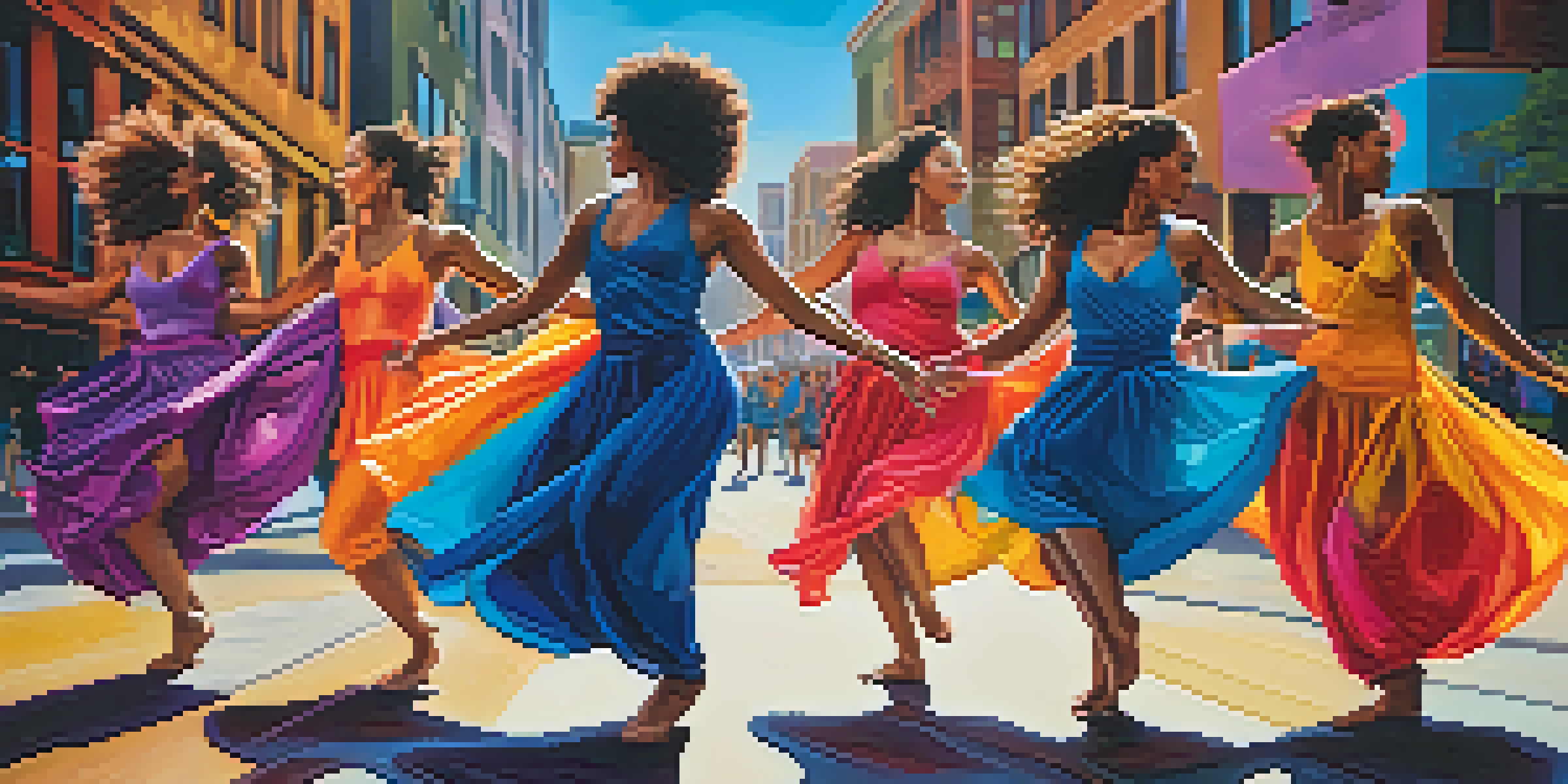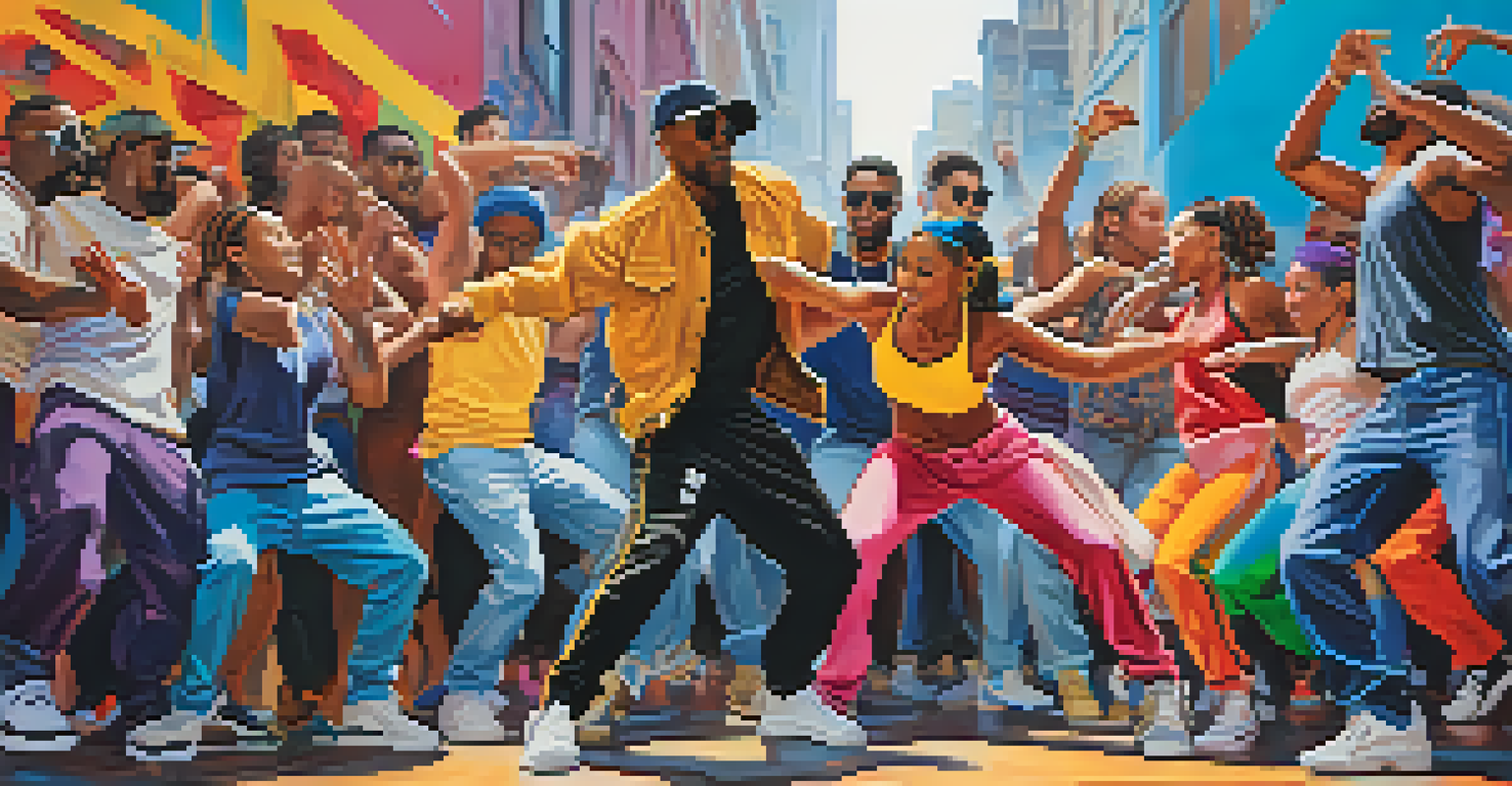Dance as a Form of Feminist Activism and Expression

Understanding Dance as a Feminist Medium
Dance has long been a form of expression, and in recent years, it has become a powerful medium for feminist activism. Through movement, dancers can convey emotions and messages that words sometimes cannot. This art form allows women to reclaim their bodies and narratives, promoting self-empowerment and challenging societal norms. For many, dance becomes a language that speaks to the heart of feminist issues.
Dance is the hidden language of the soul.
By utilizing different styles of dance, from ballet to hip-hop, activists can highlight various aspects of the feminist movement. Each style carries its own cultural weight and can resonate with diverse audiences. For instance, contemporary dance often explores themes of vulnerability and strength, while street dance can symbolize resistance and empowerment in urban environments. This versatility makes dance a unique platform for feminist messages.
Moreover, dance encourages community and collaboration, fostering a sense of solidarity among women. Workshops and performances often bring together individuals from various backgrounds, creating a shared space for dialogue and expression. This collective experience not only amplifies feminist voices but also nurtures a supportive environment where women can thrive.
Historical Context: Dance and Feminism's Intertwined Journey
The relationship between dance and feminism is rich with history, dating back to the suffragette movement. Early feminists utilized dance as a means of drawing attention to their causes, using public performances to advocate for women's rights. These early pioneers understood that dance could convey messages of freedom and equality in a way that was both engaging and impactful.

As the feminist movement evolved, so did the styles of dance used for activism. In the 1970s, figures like Judith Jamison and the Alvin Ailey American Dance Theater began to celebrate African American culture through dance, challenging racial and gender stereotypes. This fusion of cultural identity and feminist expression showcased how dance could serve as a vehicle for social change.
Dance as Feminist Expression
Dance serves as a powerful medium for feminist activism, enabling women to reclaim their narratives and challenge societal norms.
Today, the legacy of these historical movements continues to inspire modern dancers and choreographers. Many contemporary artists draw on this rich history to create pieces that address current feminist issues, such as body positivity and the fight against violence. By understanding the past, today’s activists can create more resonant and meaningful performances.
Dance as a Tool for Body Positivity and Self-Expression
In a world where societal standards often dictate how women should look and behave, dance offers a liberating escape. Many feminist dancers use their bodies to challenge conventional beauty norms, showcasing diverse shapes, sizes, and abilities. This celebration of all bodies promotes self-acceptance and encourages audiences to embrace their own individuality.
To be yourself in a world that is constantly trying to make you something else is the greatest accomplishment.
For instance, performances that highlight themes of body positivity can empower women to appreciate their bodies rather than criticize them. Dance allows individuals to express their feelings about their bodies in a way that is dynamic and relatable. Through movement, dancers can communicate the importance of loving oneself, regardless of societal expectations.
Moreover, dance provides a safe space for women to explore and express their identities. Whether it's through improvisation or choreographed pieces, dancers can use their art to tell personal stories. This authenticity fosters connections with audiences, inviting them to reflect on their own experiences and encouraging broader conversations about body image and self-worth.
Challenging Gender Norms in Dance Styles
Many traditional dance forms have been historically dominated by specific gender roles. For instance, ballet often emphasizes femininity through delicate movements and traditional narratives. However, feminist dancers are redefining these roles, challenging the expectations tied to gender in dance and creating more inclusive spaces.
By incorporating elements from various dance styles, feminists are breaking free from the constraints of traditional choreography. Styles like hip-hop, breakdancing, and even belly dancing allow for a broader expression of gender and identity. This blending of forms not only empowers women but also invites men to explore their own expressions of femininity.
Historical Roots of Dance Activism
The intertwining history of dance and feminism showcases how early activists used movement to advocate for women's rights and inspire contemporary artists.
As more dancers embrace this fluidity, the dance community becomes a more inclusive environment. Performances that defy gender norms can inspire audiences to reconsider their own perceptions of masculinity and femininity. This shift encourages a more expansive understanding of identity, demonstrating that dance can be a platform for challenging societal constructs.
The Role of Technology in Feminist Dance Activism
In today's digital age, technology plays a significant role in amplifying feminist messages through dance. Social media platforms like Instagram and TikTok provide dancers with the opportunity to share their performances with a global audience. This reach allows for powerful movements to gain traction and inspire others to join the cause.
For example, dance challenges that promote feminist themes can quickly go viral, creating a sense of community among participants. These online movements often encourage individuals to express their thoughts and feelings, fostering a supportive space for dialogue. As a result, dance becomes a form of activism that transcends geographical boundaries.
Furthermore, online platforms allow for the documentation and preservation of feminist dance works. Choreographers can share their pieces, ensuring that important messages are not lost over time. This preservation not only honors the past but also inspires future generations of dancers to continue the fight for equality through movement.
Collaborations Between Dancers and Activists
The intersection of dance and activism often leads to powerful collaborations that amplify feminist messages. Dancers frequently partner with grassroots organizations, using their art to bring attention to pressing issues like domestic violence, sexual harassment, and reproductive rights. These partnerships create a unique synergy that enhances the impact of both art and activism.
For instance, a dance performance addressing domestic violence can be paired with community outreach programs that support survivors. This dual approach not only raises awareness but also provides tangible resources for those in need. By combining their strengths, dancers and activists can create a more comprehensive response to societal issues.
Technology Amplifies Dance Activism
In the digital age, social media enhances the reach of feminist dance movements, allowing for greater community engagement and preservation of important messages.
Moreover, these collaborations often result in innovative performances that challenge audiences to confront uncomfortable truths. Dancers are able to weave narratives that resonate deeply, prompting discussions around difficult topics. This capacity for storytelling through movement allows for a profound exploration of feminist issues, making the art form a catalyst for change.
The Future of Dance as Feminist Activism
As we look toward the future, the role of dance in feminist activism is likely to continue evolving. New generations of dancers and choreographers are increasingly aware of the need for social change, using their platforms to address contemporary issues. This awareness ensures that dance remains a relevant and powerful tool for expression and activism.
Emerging styles and trends in dance continue to challenge traditional norms, reflecting the diversity of feminist thought. As intersections between race, class, sexuality, and gender become more prominent, dance will likely adapt to incorporate these complexities. This evolution will create richer narratives that resonate with broader audiences.

Ultimately, the future of dance as feminist activism is bright. With increasing visibility and acceptance, dancers will continue to use their art to challenge societal norms and inspire change. As they do so, they will undoubtedly empower others to find their own voices and express their identities through the transformative power of movement.